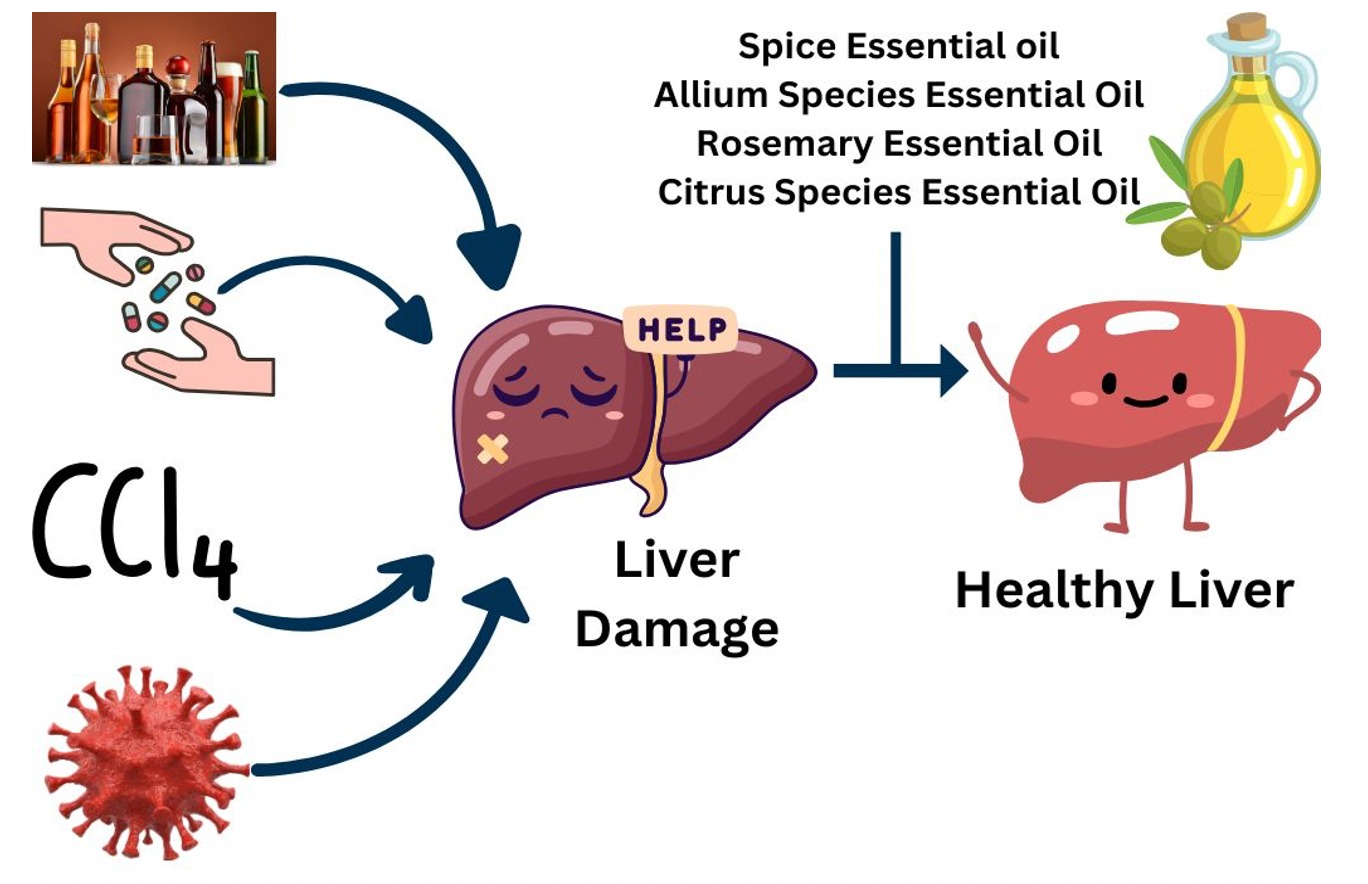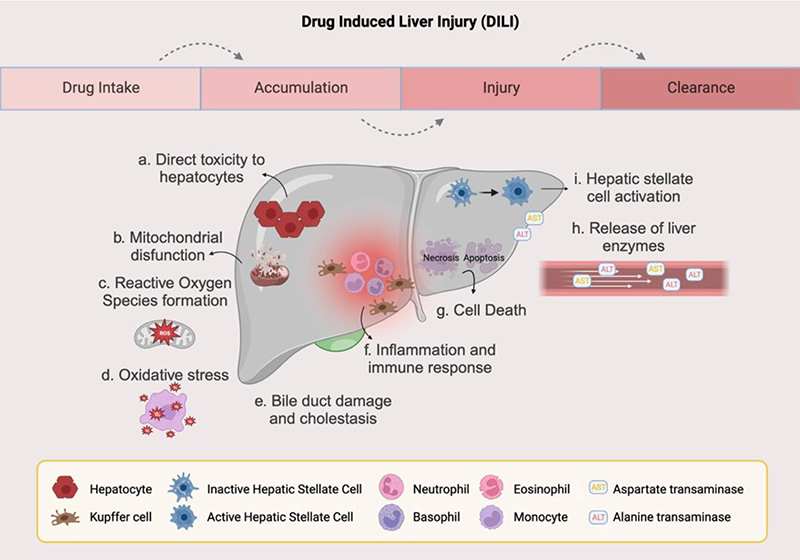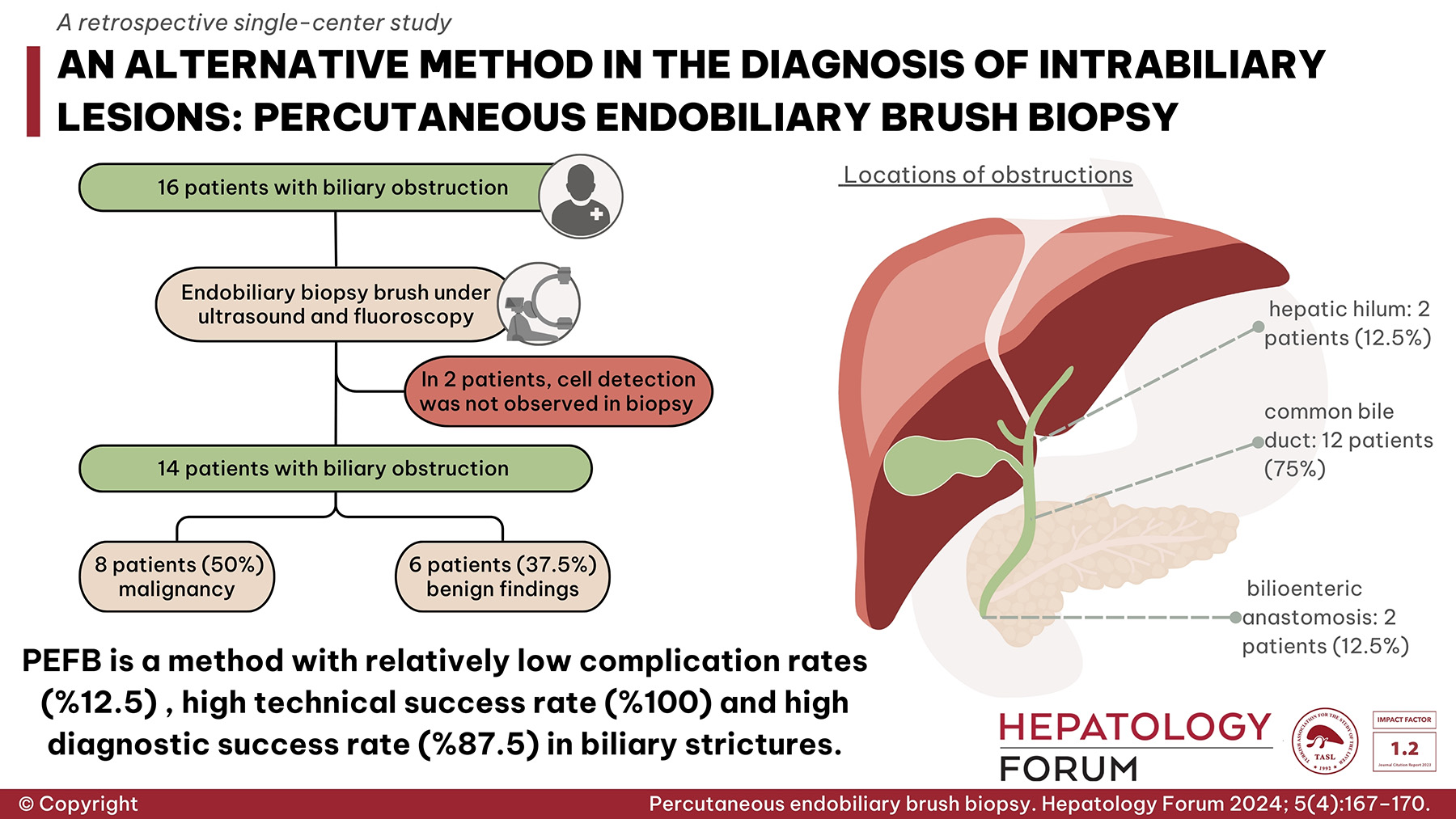2Department of Pathology, Hacettepe University School of Medicine, Ankara, Turkey
3Division of Gastroenterology, Department of Internal Medicine, Hacettepe University School of Medicine, Ankara, Turkey
Abstract
The presence of autoantibody positivity with an elevated ferritin level and high transferrin saturation can create a diagnostic dilemma. This report describes the challenging case of 38-year-old male patient who presented with new-onset diabetes, malaise, weight loss, dark-yellow skin discoloration, and splenomegaly. Initial laboratory tests revealed thrombocytopenia, leucopenia, an elevated unconjugated bilirubin level, and mildly elevated liver enzymes in a cholestatic pattern. Antinuclear antibody and anti-smooth muscle antibody findings were positive with titers of 1/160 and 1/320, respectively, along with hypergammaglobulinemia. The transferrin saturation value was 92% and the ferritin level was 498 µg/L. HFE gene mutation analysis revealed a C282Y heterozygote mutation, which is not diagnostic, but supported a diagnosis of hereditary hemochromatosis (HH). A liver biopsy is the most accurate way to differentiate autoimmune hepatitis from HH, and confirmed a diagnosis of HH. This case highlights the importance of paying close attention to all findings to avoid misdiagnosis and treatment which might result in dangerous outcomes. Additionally, in spite of a genetic test, a liver biopsy has great value as an important tool to determine an accurate diagnosis in patients with iron overload, especially in patients with concomitant autoantibody positivity.
Introduction
Iron overload can create a diagnostic dilemma in patients with chronic liver disease. Abnormal serum iron studies implying iron overload can be either primary, as in cases of hereditary hemochromatosis (HH), or secondary to chronic inflammation, which is associated with chronic liver disease, such as alcoholic liver disease, non-alcoholic fatty liver disease, chronic viral hepatitis and, very rarely, autoimmune hepatitis (AIH).[1] HH is characterized by the abnormal accumulation of iron not only in parenchymal cells of the liver, but also in the endocrine glands, heart, and skin.[2] Secondary iron accumulation primarily affects reticuloendothelial cells. Extensive diagnostic workup may be required to differentiate between primary and secondary iron overload.
Analysis of the circulating autoantibodies may be useful in the diagnosis of various autoimmune disorders, including AIH. These autoantibodies may also be incidentally discovered in healthy individuals.[3] The increased prevalence of concurrent autoantibody positivity in patients with other chronic liver diseases, such as non-alcoholic liver disease, chronic hepatitis C virus infection, or drug-induced liver injury, is also a well-known clinical entity. However, the possible linkage between hemochromatosis and predisposition to autoimmunity is still under investigation.[4,5] A limited number of patients cases of AIH with abnormally high transferrin saturation percentages and ferritin levels have been reported.[6–10] Physicians should also be aware that coincidental autoantibody positivity and hypergammaglobulinemia may mask underlying insidious HH, and may lead to misdiagnosis of AIH which is more prevalent than HH.
This report describes a cirrhotic patient with iron overload who had new-onset diabetes, hypergammaglobulinemia, and high titers of autoantibodies.
Case Report
A 38-year-old male patient with new-onset diabetes was referred to the gastroenterology clinic due to bicytopenia. His chief complaints were malaise and weight loss. A physical examination revealed dark-yellow discoloration of the skin and splenomegaly. He denied any use of alcohol, illicit drugs or herbal products. There was no significant family history of liver disease. Laboratory tests revealed thrombocytopenia, leucopenia, an elevated unconjugated bilirubin level, and mildly elevated liver enzymes in a cholestatic pattern (alanine aminotransferase/alkaline phosphatase ratio <2) (Table 1). Viral hepatitis (hepatitis A, B, C, and E) was ruled out with a negative viral panel. Antinuclear antibody (ANA) and anti-smooth muscle antibody (ASMA) were positive with titers of 1/160 and 1/320, respectively, as well as hypergammaglobulinemia. The transferrin saturation was 92% and the ferritin level was 498 µg/L. Magnetic resonance imaging (MRI) revealed a cirrhotic liver with multiple siderophilic nodules, portal vein thrombosis, an atrophic pancreas, splenomegaly, a splenorenal shunt, and esophageal varices. A liver biopsy performed in spite of the thrombocytopenia revealed mild lymphocytic inflammatory infiltrate in the portal areas, local piecemeal necrosis, and hepatocyte-predominant iron deposition (Fig. 1). The modified hepatic activity index score was 3/18 and the fibrosis score was 5/6. HFE gene mutation analysis revealed a C282Y heterozygote mutation.
Discussion
This case was a diagnostic challenge; the presence of both iron overload and strong autoantibody positivity made both HH and AIH considerations. The liver biopsy was to key to resolving the conflict, as it confirmed HH and ruled out AIH.
HH is the most commonly identified genetic disorder in Caucasians, with the highest prevalence among populations of northern European descent. The underlying pathophysiological mechanisms include decreased expression of hepcidin and increased absorption of dietary iron as a result of gene mutations. The identified main genetic defect is a C282Y homozygote mutation in the HFE gene, accounting for 80% to 85% of HH patients (HFE-related HH). However, because of variable penetrance, fewer than 10% of people carrying a C282Y homozygote mutation encounter end-organ damage. Two other important HFE gene mutations are H63D and S65C mutations, which are most often detected as compound heterozygosity, meaning that a C282Y mutation is present in 1 allele and an H63D or S65C mutation is present in other.[1] Clinical presentations develop much less frequently in patients with compound heterozygote mutations than in those with a C282Y homozygote mutation.[11] In addition, mutations in other genes coding several proteins of iron metabolism leading to the hereditary iron overload syndromes (non-HFE related HH) have been identified over the last 20 years.[1,11] Although the high frequency of a C282Y mutation in Europe allows for a diagnostic algorithm based on mutation analysis, HFE-related HH is very rare in Turkey. A C282Y mutation has not been detected in either the general population or among HH patients in Turkey (Table 2).[12,13] Therefore, HFE gene mutation analysis may not be a judicious approach as a first step in an HH diagnostic evaluation in some populations. HFE gene mutation analysis was used in our case due to a high clinical suspicion of HH. The presence of a C282Y heterozygote mutation was a supportive finding, considering the rarity of HFE mutation in the Turkish population.
Secondary iron overload is a much more common clinical condition than HH. The differential diagnosis includes a wide range of diseases, including, but not limited to iron-loading anemias, parenteral iron treatment, and chronic inflammation associated with other chronic liver diseases, like chronic viral hepatitis, alcoholic liver disease, and non-alcoholic liver disease.[1] Elevated ferritin levels as a positive acute-phase reactant together with normal transferrin saturation can be seen in AIH, but AIH associated with iron overload is an extremely rare condition. To our knowledge only 5 cases of AIH with an elevated ferritin level and high transferrin saturation have been reported in the literature. In 3 of those cases, HH was strongly considered due to abnormally high transferrin saturation and ferritin levels. Case 1 reported transferrin saturation and ferritin values of 89% and 1570 µg/L, respectively, with a negative HFE gene mutation;[6] case 2 recorded values of 91% and 2463 µg/L, and HFE gene mutation analysis not performed;[7] case 3 observed values of 78% and 1800 µg/L, and noted an H63D heterozygote mutation,[8] but liver biopsies revealed only AIH in all 3 cases. Case 4 was a patient with liver failure and hyperferritinemia (ferritin: 16900 µg/L) and AIH was diagnosed with a liver biopsy.[9] In case 5, a diagnosis of both AIH and HH was made since patient had a transferrin saturation of 94%, a ferritin level of 8190 µg/L, an HFE gene mutation and positive ASMA results at a titer of 1/640, and the liver biopsy showed severe sideronecrosis and plasmacytosis with acute hepatocyte damage.[10]
The coexistence of HH and autoimmune conditions is an area of ongoing research, and it has been suggested that HFE gene mutations may predispose patients with HH to autoimmune diseases.[5] This predisposition may lead to coincidental positivity of liver specific autoantibodies, and misdiagnosis of AIH. In our case, autoantibody positivity at high titers and hypergammaglobulinemia created a diagnostic challenge, even though HH was strongly suspected due to the concomitant presence of new-onset diabetes and jaundiced skin pigmentation in a young male patient with cirrhosis. Furthermore, the pancreatic atrophy resulting in diabetes was attributed to iron accumulation rather than immune origins. HH was diagnosed based on the high ferritin level associated with markedly increased transferrin saturation and the iron accumulation in the liver seen in the MRI. The liver biopsy not only confirmed primary iron accumulation in the hepatocytes, but also excluded AIH.
In conclusion, this case presented a diagnostic question that emphasizes the importance of paying close attention to all clinical and laboratory findings in order to avoid misdiagnosis of AIH in a patient with iron overload and autoantibody positivity. Since the management of AIH and HH are completely different, the misdiagnosis of AIH or missing the diagnosis of HH might result in troublesome outcomes. We believe that the liver biopsy plays a crucial role in determining the accurate diagnosis in the presence of both autoantibody positivity, an elevated ferritin level and a high transferrin saturation percentage.
Informed Consent: Written informed consent was obtained from the patients for the publication of the case report and the accompanying images.
Peer-review: Externally peer-reviewed.
Author Contributions: Concept – NYK, BK, CS, YB; Design – NYK, BK, CS, YB; Supervision – NYK, BK, CS, YB; Resource – NYK, BK, CS, YB; Materials – NYK, BK, CS, YB; Data Collection and/or Processing – CS; Analysis and/or Interpretation – NYK, BK, CS, YB; Literature Search – NYK, BK; Writing – NYK, BK; Critical Reviews – YB.
Conflict of Interest: The authors have no conflict of interest to declare.
Financial Disclosure: The authors declared that this study has received no financial support.
References
1. Bacon BR, Adams PC, Kowdley KV, Powell LW, Tavill AS; American Association for the Study of Liver Diseases. Diagnosis and management of hemochromatosis: 2011 practice guideline by the American Association for the Study of Liver Diseases. Hepatology 2011;54(1):328-343. [CrossRef]
2. Pietrangelo A. Hereditary hemochromatosis: pathogenesis, diagnosis, and treatment. Gastroenterology 2010;139(2):393-408. [CrossRef]
3. Pashnina IA, Krivolapova IM, Fedotkina TV, Ryabkova VA, Chereshneva MV, Churilov LP, et al. Antinuclear Autoantibodies in Health: Autoimmunity Is Not a Synonym of Autoimmune Disease. Antibodies (Basel) 2021;10(1):9. [CrossRef]
4. Aizawa Y, Hokari A. Autoimmune hepatitis: current challenges and future prospects. Clin Exp Gastroenterol 2017;10:9-18. [CrossRef]
5. Reuben A, Chung JW, Lapointe R, Santos MM. The hemochromatosis protein HFE 20 years later: An emerging role in antigen presentation and in the immune system. Immun Inflamm Dis 2017;5(3):218-232. [CrossRef]
6. An IC, Tiwari AK, Ameda S, Laird-Fick HS. Autoimmune hepatitis: diagnostic dilemma in the setting of suspected iron overload. Case Rep Gastrointest Med 2013;2013:872987. [CrossRef]
7. Acharya GK, Liao HI, Frunza-Stefan S, Patel R, Khaing M. Autoimmune Hepatitis: Diagnostic Dilemma When It Is Disguised as Iron Overload Syndrome. J Clin Exp Hepatol 2017;7(3):269-273. [CrossRef]
8. Bollimunta P, Ganipisetti V, Tun NN. Autoimmune Hepatitis Mimicking Hemochromatosis: 2931. Official Journal of the American College of Gastroenterology 2017;112:S1565. [CrossRef]
9. Nguyen D, Blechacz B, Francis D. Autoimmune Hepatitis Presenting with Profound Hyperferritinemia and Transaminitis: 732. Official Journal of the American College of Gastroenterology 2011;106:S276. [CrossRef]
10. Warner BD, Mackenzie G. A rare case of a dual diagnosis of liver disease J Med Cases 2013;4(6):362-364. [CrossRef]
11. Salgia RJ, Brown K. Diagnosis and management of hereditary hemochromatosis. Clin Liver Dis 2015;19(1):187-198. [CrossRef]
12. Simsek H, Balaban YH, Yilmaz E, Sumer H, Buyukasik Y, Cengiz C, et al. Mutations of the HFE gene among Turkish hereditary hemochromatosis patients. Ann Hematol 2005;84(10):646-649. [CrossRef]
13. Simsek H, Sumer H, Yilmaz E, Balaban YH, Ozcebe O, Hascelik G, et al. Frequency of HFE mutations among Turkish blood donors according to transferrin saturation: genotype screening for hereditary hemochromatosis among voluntary blood donors in Turkey. J Clin Gastroenterol 2004;38(8):671-675. [CrossRef]
14. Barut G, Balci H, Bozdayi M, Hatemi I, Ozcelik D, Senturk H. Screening for iron overload in the Turkish population. Dig Dis 2003;21(3):279-285.
15. Bozkaya H, Bektas M, Metin O, Erkan O, Ibrahimoglu D, Dalva K, et al. Screening for hemochromatosis in Turkey. Dig Dis Sci 2004;49(3):444-449.
16. Simsek H, Balaban YH, Sümer H, Yilmaz E, Tatar G. HFE mutations analysis of Turkish patients with nonalcoholic steatohepatitis. Dig Dis Sci 2006;51(10):1723-1724. [CrossRef]
17. Yonal O, Hatirnaz O, Akyuz F, Koroglu G, Ozbek U, Cefle K, et al. Definition of C282Y mutation in a hereditary hemochromatosis family from Turkey. The Turkish Journal of Gastroenterology 2007;18(1):53-7.
18. Dulger AC, Esen R, Mete R, Begenik H, Aytemiz E, Tasdemir M, et al. The prevalence of hereditary hemochromatosis in some men from the Eastern part of Turkey and the effects of H63D mutations on iron studies. Clinical Chemistry and Laboratory Medicine 2012;0(0):1-4.
19. Karaca H, Guven K, Onal M, Gursoy S, Baskol M, Ozkul Y. The prevalence of primary hereditary hemochromatosis in central Anatolia. The Turkish journal of gastroenterology 2013;24(1):43-50. [CrossRef]
20. Unal S, Balta G, Gümrük F, Xu HG. Survey of Hfe Gene C282Y Mutation in Turkish Beta-Thalassemia Patients and Healthy Population: A Preliminary Study. Turk J Haematol 2014;31(3):272-275. [CrossRef]
21. Ozturk S, Luleci G, Keser I. Frequency of Three Hemochromatosis Gene Mutations in Antalya, Turkey. Balkan Journal of Medical Genetics 2007;10(1):25-28. [CrossRef]





 Nur Yazdalı Koylu1
Nur Yazdalı Koylu1 









